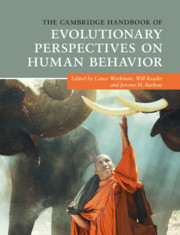Book contents
- The Cambridge Handbook of Evolutionary Perspectives on Human Behavior
- The Cambridge Handbook of Evolutionary Perspectives on Human Behavior
- Copyright page
- Dedication
- Contents
- Figures
- Tables
- Contributors
- Preface
- Acknowledgments
- Part I The Comparative Approach
- Part II Sociocultural Anthropology and Evolution
- Part III Evolution and Neuroscience
- Part IV Group Living
- Part V Evolution and Cognition
- Part VI Evolution and Development
- Part VII Sexual Selection and Human Sex Differences
- Part VIII Abnormal Behavior and Evolutionary Psychopathology
- Part IX Applying Evolutionary Principles
- 36 A Bridge Too Far?
- 37 The Evolution of Personality
- 38 Applying Evolutionary Principles to Criminality
- 39 Substitute Parenting
- 40 Historians and the Evolutionary Approach to Human Behavior
- 41 The Psychology of Extraterrestrials
- Part X Evolution and the Media
- Index
- References
38 - Applying Evolutionary Principles to Criminality
from Part IX - Applying Evolutionary Principles
Published online by Cambridge University Press: 02 March 2020
- The Cambridge Handbook of Evolutionary Perspectives on Human Behavior
- The Cambridge Handbook of Evolutionary Perspectives on Human Behavior
- Copyright page
- Dedication
- Contents
- Figures
- Tables
- Contributors
- Preface
- Acknowledgments
- Part I The Comparative Approach
- Part II Sociocultural Anthropology and Evolution
- Part III Evolution and Neuroscience
- Part IV Group Living
- Part V Evolution and Cognition
- Part VI Evolution and Development
- Part VII Sexual Selection and Human Sex Differences
- Part VIII Abnormal Behavior and Evolutionary Psychopathology
- Part IX Applying Evolutionary Principles
- 36 A Bridge Too Far?
- 37 The Evolution of Personality
- 38 Applying Evolutionary Principles to Criminality
- 39 Substitute Parenting
- 40 Historians and the Evolutionary Approach to Human Behavior
- 41 The Psychology of Extraterrestrials
- Part X Evolution and the Media
- Index
- References
Summary
In this chapter, we consider how developments in evolutionary theory might be applied to help us understand why some people gravitate toward criminal behavior. Sociologists generally explain the emergence of criminal behavior in terms of responses to unfavorable societal factors. In contrast, social and developmental psychologists explain such behavior as the outcome of the interaction between individual differences and a challenging rearing environment. Evolutionary psychologists, however, bring a whole new perspective to the problem of criminality (Taylor & Workman, 2019). They suggest that evolutionary principles such as kin selection theory, reciprocation, sexual selection, and parental investment theory can provide powerful tools to help explain criminality. Before considering how these principles might be applied, we need first to explore what is meant by the concept of “criminality.”.
Defining criminality and, in particular, what encapsulates criminal behavior is far from straightforward. For a definition of what constitutes criminal behavior and criminality as an underlying cognitive and personality dimension, it is appropriate to adopt a legal approach.
- Type
- Chapter
- Information
- Publisher: Cambridge University PressPrint publication year: 2020



